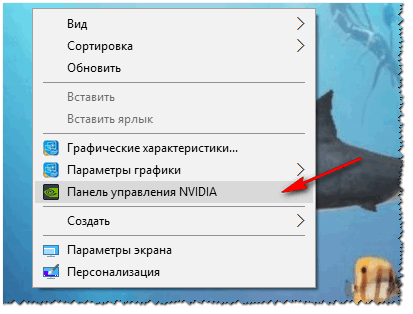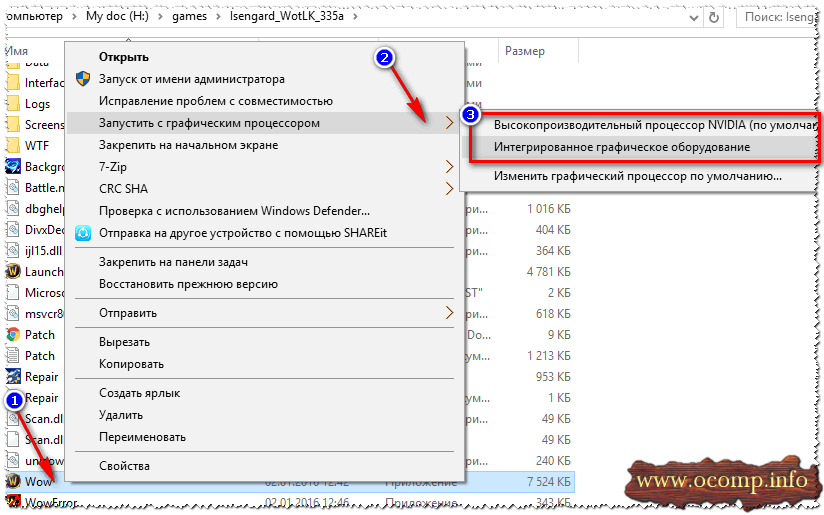Graphics processor – choose the more preferable one. How to run a game on a discrete video card. How to check which video card the game is running on (using NVIDIA as an example) How to run games with a high-performance nvidia processor
Do you know how to choose the more preferable graphics processor from the two available options for running an application or game? If not, then I suggest laptop owners read this article.
Today, even an average laptop in terms of cost and performance comes with two video cards. The first, which works by default, is built-in, the second is discrete. An additional GPU is mostly found on gaming laptop models, but it is not uncommon to find it on a non-gaming setup.
Of the built-in ones, the choice is small and usually it is a chip from Intel, but discrete ones can be from Nvidia or AMD. These are the most common and trusted products by users. And manufacturers, first of all, try to complete devices based on our preferences.
Now let's briefly look at the process of interaction between two video cards. When the demands of any running application exceed the capabilities of the integrated card, your system automatically switches to a discrete card. This happens mainly when you start playing games.
As mentioned above, the PC market is dominated by two major GPU manufacturers. It is worth noting that the most widely used Nvidia uses the relatively new “Optimus” technology. Its functionality lies in the fact that whenever it detects that a program or game needs additional, more powerful resources, a dedicated GPU is automatically used.
Now I'll show you how you can easily force an application to use a high-performance or integrated GPU of the user's choice. This will only be demonstrated today with NVIDIA and Intel.
GRAPHICS PROCESSOR
Open NVIDIA Control Panel. The easiest and fastest way is to right-click on the corresponding icon located on the Taskbar in the lower right corner. Go to the “Desktop” menu and check the box next to “Add an item to the context menu”.
Now, after these simple steps, you can right-click on the shortcut of any application and, in the menu item that appears, select one of two launch options.

CONTINUOUS START
And if you decide to always use only a discrete video card, then you need to go to the “Manage 3D Settings” section in the Control Panel, select the “Program Settings” tab and install the required game or program in step 1, and select the desired video card in step 2 , then click on the “Apply” button.

That's it! Visit and check out all the computer tips available. Become a member of our FB group where you can get help, participate in discussions or post your point of view.
User question
Hello.
I have two video cards on my laptop: built-in Intel HD and discrete NVIDIA. For some reason, many games are slow (and some of them are old), I suspect that they run on the built-in video card.
How do I find out what card they work on, and if not on a discrete one, then how to use it? Thanks in advance...
Good day!
In fact, many modern laptops are equipped with two video cards: one built-in (usually Intel HD) - used when working in Windows, viewing pictures, videos, and not too resource-intensive games; the second is a discrete AMD or NVIDIA, necessary for running games and programs that require high performance from the video adapter.
According to the developers, the discrete video card should be activated automatically when the game starts (the rest of the time, to save battery power, the built-in video card must work) . But this does not always happen, and some games run on the built-in one - as a result, you see brakes, lags, delays, etc. In this article I will give several ways to run games on a discrete video card.
Note: in my manual below I will show how to configure a discrete video card using NVIDIA as an example. If you have an AMD video card, the menu will be slightly different, but the setup principle will not change (see screenshots in the comments).
Important!
Before moving on to the methods and fine-tuning, you must have the latest video drivers installed (at least not the ones that come installed by default with Windows). I recommend using one of the driver managers to automatically update and install new drivers (link below).
Updating drivers in Windows 10 - review of the 5 best programs (in Russian) -
How to update the driver for an AMD, nVidia and Intel HD video card: from A to Z -
Method No. 1: using the video driver settings menu
If you have the drivers installed, then by right-clicking anywhere on the desktop, in the pop-up context menu, you should see a link to setting them up (in my case this is a link to "NVIDIA Control Panel" ) . Let's move on to setting up discrete video card drivers.


After this, you can try to launch the game - it should launch on a discrete video card.
By the way, in the NVIDIA settings you can also specify the specific video card used for a specific game. To do this you need to do the following:
- open the video card settings, then the tab "Manage 3D Settings" ;
- then open the tab "Program settings" ;
- add the desired program (in my case, added a game Civilization 4);
- and set the preferred GPU for this application (see screenshot below);
- save settings!

Method number 2: through the conductor
If you specify certain settings in the NVIDIA settings, you will be able to run any games and programs on the adapter you need in manual mode.
To do this, open NVIDIA settings, then in the section "Desktop " (menu at the top) check a couple of boxes:
- Add to desktop context menu;
- Add item "Run with GPU" to the context menu.

If you have enabled the previous couple of checkboxes, then the most obvious and easiest way to launch the game on the desired video adapter is to open Explorer, that is, the desired folder in which the executable file with the game is located, and right-click on the game file (by the way, you can do this and by icon on the desktop).

Actually, the game should run on the adapter you choose. Now below I will consider a way to check if this is true...
How to check if a game runs on a discrete video card
First, go to the settings of the NVIDIA video card and open the menu "Desktop" . There is one option you need to enable in this menu "Display the GPU activity icon in the notification area" . This icon will allow you to see when the NVIDIA adapter is loaded, in fact, what we are looking for...

By the way, please note that after enabling this option, a corresponding icon will appear in your tray, next to the clock (see screenshot below).

Now let's start the game. If the game is running in full screen mode, minimize it using the buttons WIN or Alt+TAB.
Please note that the NVIDIA GPU icon has become colored (in the screenshot below). Those. The NVIDIA adapter started working after starting your game - that means it is enabled!

The icon became colored after starting the game (bottom)
By also clicking on this icon, you can see which games (applications) are currently using this adapter (see screenshot below).

In general, this is the most relevant and reliable way to determine whether a discrete video card is enabled.
Using FPS analysis
You can also indirectly determine whether you have a discrete video card in use by the number (number of frames in the game). For a discrete video card it is usually higher.
To see the number of FPS in games, install one of several applications: Fraps, PlayClaw, Overwolf. Then deliberately launch some game on the built-in and discrete video cards, and see the difference (see screenshot below)!
If necessary, increase the graphics settings to maximum to fully utilize the resources (for a more obvious difference).

And one more thing!
Pay attention to the noise and operating temperature of your laptop. If a discrete graphics card is used, many laptop models begin to make noticeably louder noise. The temperature of the video adapter also begins to rise (it can be, for example, Speccy, screenshot below).

Why the game may not run on a discrete video card
Some games stubbornly refuse to run on a discrete video card. You set everything in the driver settings, manually specify how to launch it, but all the same, the game runs on the built-in one, lags and slows down. In this case, I recommend several things (came across it myself, several times)!
1. Try another OS, such as Windows 7
The story is simple. On one laptop, I couldn’t understand for a long time why one old game stubbornly wouldn’t run on a discrete video card (by the way, Windows 10 was installed on it). Then I decided to create another partition on the hard drive and install a second OS - Windows 7. Surprisingly, in Windows 7 the game launched without problems on a discrete video card.
Conclusion: Windows 10 does not work correctly with two video cards (built-in and discrete) and old games. This may also be due to the drivers, which are not yet fully optimized for the “new” Windows 10.

2. Try turning on compatibility mode and disabling scaling
To do this, simply open the properties of the desired EXE file. Next, in the "Compatibility" section, check the box "Run the program in compatibility mode for such and such Windows" (example below).

3. Try installing an older version of the driver (for the video card)
And lastly. The newest driver is not always the best. It is possible that there is some kind of bug in the new driver and the discrete card is not activated when the game starts. Therefore, you should try an older version of the driver, which has already been tested for many months (years).
Help!
Restoring an old working driver: rolling back to a previous version -
That's all for me, I hope I answered the original question in detail.
Sometimes it becomes necessary to run this or that application or game with an NVidia or Intel video card in manual mode, but not all users know how to choose a video chip. Today we will tell you how to switch the video card on a laptop from NVidia to Intel and vice versa, so that you can independently select the desired video chip.
Why do you need manual switching if it is carried out automatically?
The fact is that then you will have the opportunity to save battery. For example, you are running some game with fairly low video card requirements. By default, your Nvidia chip will immediately be activated, which will undoubtedly affect faster battery drain. That is, the first bonus we get is the ability to save battery power when running undemanding toys.Another scenario cannot be ruled out, when the application is initially launched with the “wrong” video chip, which is why it is not possible to achieve maximum performance in it. The problem may be with the application itself, causing the system to select the wrong video card. However, we can solve it in a few mouse clicks.
Switching using standard means
On new gaming laptops, even with an Intel processor, it is initially impossible to switch video chips - the second one is simply missing. Therefore, nothing will work here. As for older devices, to switch you must follow these steps:As you can see, nothing could be simpler - you just need to make just a few mouse clicks to activate the corresponding item in the Windows context menu.
What should I do if the method above does not work?
Fortunately, he is far from the only one. We'll have to go back to NVidia software again. You must do the following:
There is also a way to select a separate video chip to run each application, this is done as follows:

In conclusion, I would like to say that in new laptops, switching from a discrete to an integrated video card occurs automatically and does not require additional settings.
Updated method
Standard method (does not always work)
Currently, there is such a solution: the laptop has two video accelerators - most often an Intel HD Graphics core and a discrete chip from Nvidia, the switching mode of which can be selected in the Nvidia control panel.
Standard way:
1. In the Nvidia Control Panel, go to the Software Settings tab:
2. Click the Add button and specify the executable file of the game that we will force to launch with discrete video.
A special case is only for games that use the Java machine (Minecraft and others). What needs to be added to the list is not the game's executable file, but the Java machine itself. To do this, you first need to find where the javaw.exe file is running from. For example, you can launch the task manager, go to the Processes tab, hover over the process of interest to us, right-click and select Properties. The path will be indicated in the window that opens. I have javaw.exe in the folder C:WindowsSysWOW64 (Windows 7 Ultimate 64 bit, Java 7SE 32 bit). Once the location of the file is known, add it as described above.
3. Select Nvidia High-Performance Processor from the drop-down list.
4. Click the Apply button.
Alternative method (workable)
If the standard method does not help, there is another one - not very obvious, but quite workable.ATTENTION:
This method was tested on Windows 7.
This method does not work on Windows 10.
1. Open Screen Resolution:
2. Click the Find button. Two more monitors will appear with the words No other screen detected:
3. Select a monitor that matches the discrete video accelerator:
4. Select Try to connect to VGA anyway from the Multiple screens drop-down list and click the Apply button:
The result will be the following:
5. Select Extend these screens, click Apply, confirm saving the parameters:
Note
If your video card does not work after enabling the alternative method, do the following.
With the alternative method enabled, do additional regular and enjoy the game.
Result of the alternative method
We observe the result.
Games can now see both video cards.
TES: Skyrim settings window:
The video card monitoring gadget from 0rbmu2k now normally determines the total amount of memory, the amount of occupied memory and GPU load as a percentage:
Needless to say, games are running faster now?
By the way, I played many games by adding the executable to the Nvidia Panel using the first method. For a comfortable game, I had to set the graphics settings to the very minimum. Now FPS has increased in many games by 20-40%. In some games I didn’t see a significant increase in frames, but the lags and freezes disappeared.
Most often, laptop owners need to enable a second video card. For desktop PC users, such questions arise quite rarely, since desktops are able to determine which graphics adapter is being used at a given time. To be fair, it is worth noting that users of any computer may encounter situations where it is necessary to manually start a discrete video card.
A powerful video card, unlike a built-in one, is necessary for working in applications that actively use the graphics core (programs for video editing and image processing, 3D packages), as well as for running demanding games.
The advantages of discrete video cards are obvious:
- A significant increase in computing power, which makes it possible to work in resource-intensive applications and play modern games.
- Playback of “heavy” content, such as 4K video with high bitrate.
- Using more than one monitor.
- Possibility of upgrading to a more powerful model.
The disadvantages include high cost and a significant increase in energy consumption of the system as a whole. For a laptop, this means higher heat.
NVIDIA
The green video card can be enabled using the software included in the driver package. It's called the NVIDIA Control Panel and is located in "Control Panels" Windows.


Now all applications that work with the video card will use only the discrete adapter.
AMD
The powerful video card from the Reds is also enabled using proprietary AMD Catalyst Control Center software. Here you need to go to the section "Nutrition" and in the block "Switchable Graphics Adapters" select option "High GPU performance".

The result will be the same as in the case of NVIDIA.
The above recommendations will only work if there are no interruptions or malfunctions. Quite often, a discrete video card remains unused due to a disabled option in the motherboard BIOS, or the lack of a driver.
Driver installation
The first step after connecting the video card to the motherboard should be to install the driver necessary for the adapter to fully operate. A universal recipe suitable in most situations is:
